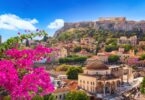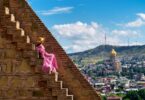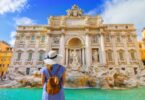On the fourth Saturday of each January, the 1,122-foot of Mount Wakakusa, located in Nara, Japan, is set ablaze during the Wakakusa Yamayaki Festival. Over 100,000 locals and tourists flock to the mountain to behold this impressive spectacle. Weather permitting, of course (If it’s not conducive for burning dried grass, the festival is postponed).
The History of Wakakusa Yamayaki
Wakakusa Yamayaki commemorates a boundary dispute that occurred in 1760 between the monks of Tōdai-ji and Kōfuku-ji (two of Nara’s Buddhist temples). The feud became so intense that the monks of the neutral Shinto shrine (Kasuga) stepped in to mediate. When negotiations failed, Mount Wakakusa was set on fire. There is another (perhaps less dramatic) legend that pertains to the burning of Mount Wakakusa: The mountain was overrun by wild boar that were creating problems for the surrounding inhabitants, so they torched the mountain. Whatever the original reason for the burning may be, the Wakakusa Yamayaki annual festival has become an integral part of Nara’s history and culture.
Getting to Wakakusa Yamayaki
Mount Wakakusa, also known as Mount Mikasa, is located in Nara (in the Nara Prefecture), to the east of Nara Park. Nara does not have an airport, so your best bet is to book cheap flights in January that fly into Kansai International Airport (KIX). From there, you can take a train (either Japan Rail or Kintetsu) directly to Nara. The Kintetsu station is the closest to the festival. From there, it is a 40-minute walk to the mountain. There is also a bus that runs from the station to Kasuga Shrine (which is about a 15-minute walk to the mountain).
YOU MAY ALSO LIKE: 6 Temples in Koyto, Japan That You Have to Visit
What Happens at Wakakusa Yamayaki
Festivalgoers begin to assemble around noon for a senbei-throwing competition. Senbei are large rice crackers (they can really catch some air) that are sold in Nara Park for tourists to feed the wild sika deer that roam freely. At approximately 5:00 pm, an interfaith religious procession starts at the Silk Road Exchange Hall in Nara Park and walks across the Mizutani Bridge to the base of Mount Wakakusa. Monks and priests from Tōdai-ji and Kōfuku-ji Buddhist temples and the Kasuga Shinto shrine dress in their traditional attire.
A large bonfire is lit at the bottom of Mount Wakakusa around 5:30 pm. The religious leaders gather around the bonfire and stay there through the impressive fireworks display (that starts around 6:00 pm). After the fireworks are done, the priests and monks light their torches from the bonfire, walk up the mountain, and set the dry grass on fire. It depends on how dry the grass is from year to year, but the actual burning typically takes about an hour.
A Couple Tips for Attending Wakakusa Yamayaki
- Since temperatures are usually in the high 30s- low 40s this time of year, it’s a good idea to dress warmly (especially since the temperature can drop rapidly at night).
- If you plan on spending the night in Nara, make sure to book accommodations well in advance, since people come from all over Japan to participate in this annual celebration.
Have you been to Japan’s Wakakusa Yamayaki Festival and have something else to add? Leave it in the comment section below!








